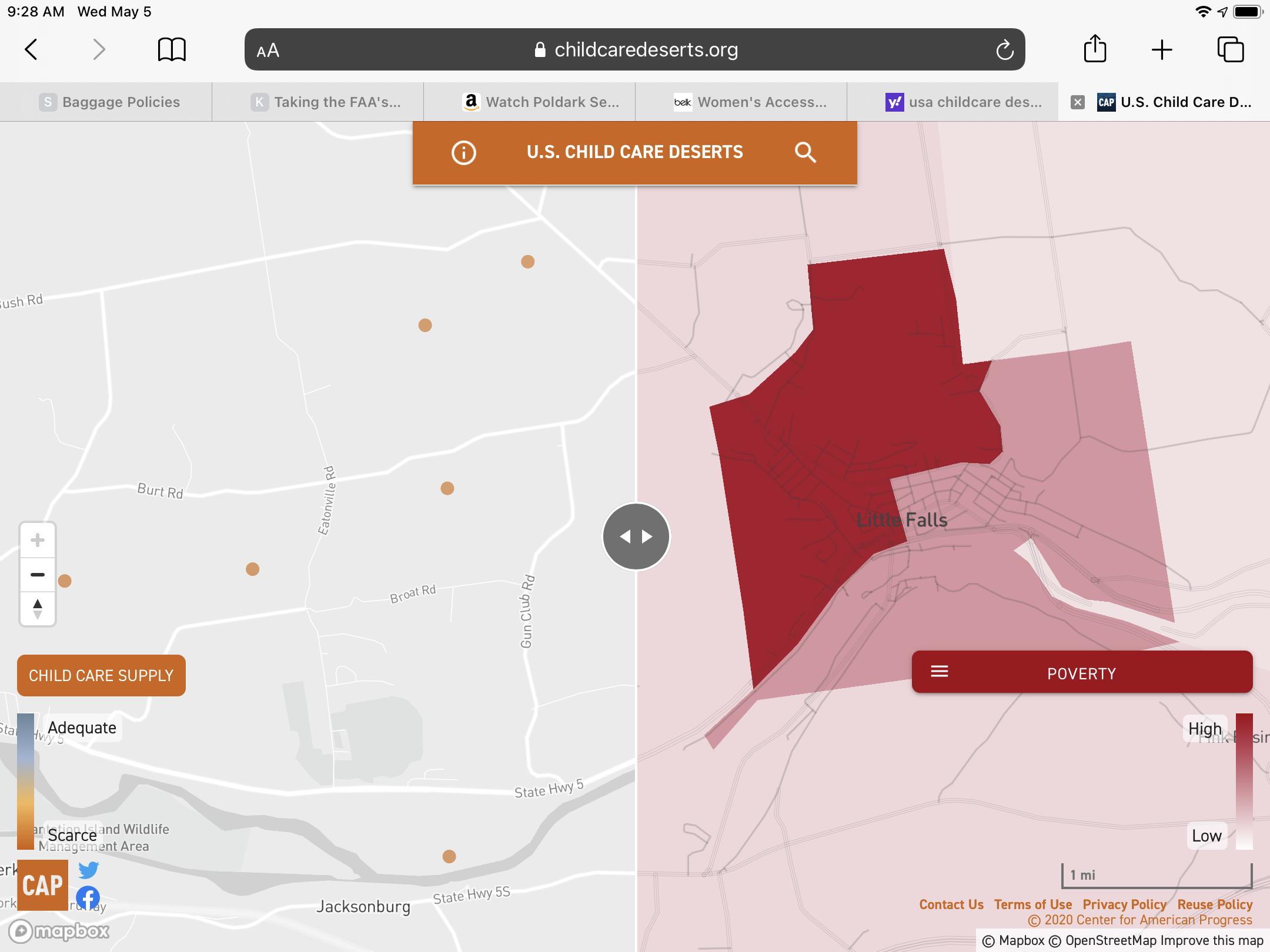
22 minute read
Justification

Provide an overview of the downtown area nominated for the DRI program, highlighting the area’s defining characteristics and the reasons for its selection. Explain why the downtown is ready for DRI investment, and how that investment would serve as a catalyst to bring about revitalization.
Advertisement
Rethinking Little Falls’ Downtown Vision
The DRI strategy for Little Falls is rooted in extensive community input since 2007 with numerous reports including the 2020 Brownfield Report, the 2018 Comprehensive Plan and the 2010 City of Little Falls Local Waterfront Revitalization Program. The year-long community dialogue detailed in the Little Falls Comprehensive Plan revealed several realistic planning priorities that became the foundation of the City’s DRI vision, including:
• A Return to Population Growth • Preserving and Revitalizing Our Central Business District • Encouraging Ongoing Development of the Waterfront as the City’s Unique Resource • Creating a Vibrant Arts and Cultural Mecca for the Region • Smart Growth to Encourage Development that Boosts the Economy, Enhances Community Vitality and Protects the Environment • Infrastructure Maintenance and Renewal • Encourage the Development of New and Updated Housing Stock • Welcoming Industrial and Service Employers • Treasuring our Heritage
While some cities are defined by their history and tradition, many in Little Falls believe the best chapters in the City’s story are yet to be written. Through the talents, innovation and perseverance of its citizens, the City is experiencing a revitalization and sense of optimism that would make its early founders proud.
The community’s extraordinary engagement, growing interest in live/work relocations, and the number of recent private investments ($11.6 million) has prompted the City and its community stakeholders to develop a cohesive, transformational vision for Little Falls that connects the Main Street and Canal Place commerce areas of the City into a single Downtown Waterfront District—the DRI target area.
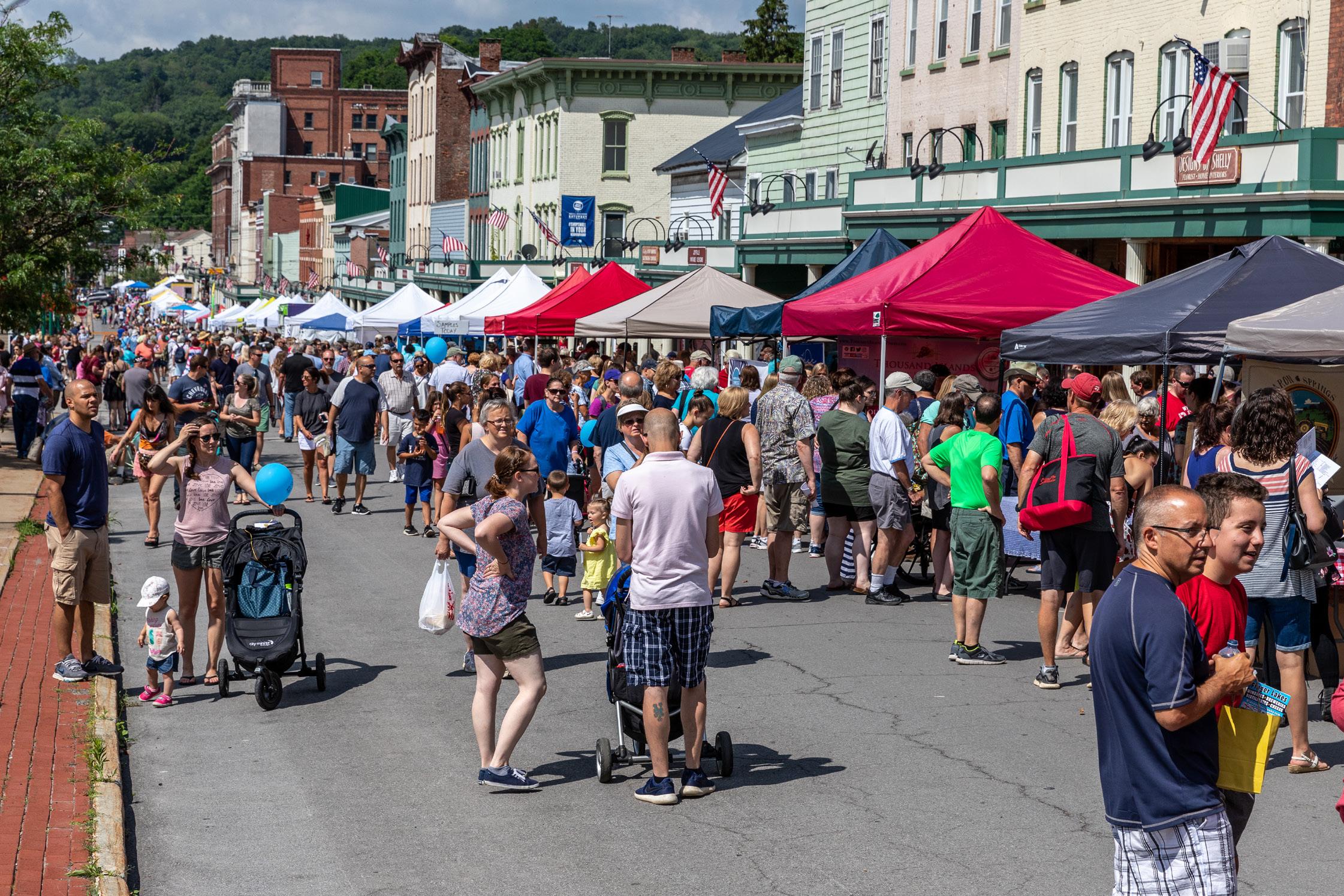
The 2019 Cheese Festival in Downtown Little Falls.
Little Falls “Iconic” Main Street
Little Falls’ Main Street has generated national interest from visitors, cinematographers and historians over the years for its exceptionally well-preserved architecture, quaint storefronts and family-owned businesses. In fact, the 2018 American science fiction horror film, A Quiet Place, directed by John Krasinski, was filmed here. Also, in May of last year, Damascus Road Productions expressed strong interest in filming three movies in Little Falls with a budget between fifteen and twenty million each. The productions would include a theatrical release with Sony Pictures partnering for distribution.
The preserved Victorian storefronts and Classic Revival City Hall, combined with the breathtaking beauty of the surrounding hills, makes the perfect backdrop for filming numerous scenes from one location.

This postcard-perfect Main Street is also known for events and festivals each year including: Canal Celebration with 10,000 visitors, Cheese Festival with 6,000 visitors, the Mohawk Valley Garlic and Herb Festival with 3,500 visitors, and the Bluegrass, Brews & BBQ Festival with 1,200 attendees.

John Krasinski scouts Little Falls locations while fans get a photo.
Even with such an attractive Main Street, the commercial vacancy rate (including upper floors of multi-story buildings) is between 35 and 40%. While these “mom and pop” stores are well supported by residents, they continue to struggle to attract new shoppers. Adding to the problem are deteriorating commercial buildings that discourage new business investment.
The DRI vision for Main Street is to transform the downtown experience by creating a more natural flow for vehicular traffic by incorporating diagonal parking, installing bike/scooter mobility for enhanced walkability, adding streetscaping and space for outdoor dining, creating a Main Street fund for storefront repairs/painting/lighting, and replacing the canopy over the storefronts with fire escapes to open up 65,000 sq. ft. of residential living space for property owners and residential investors. “ I envision the Downtown Waterfront District will...
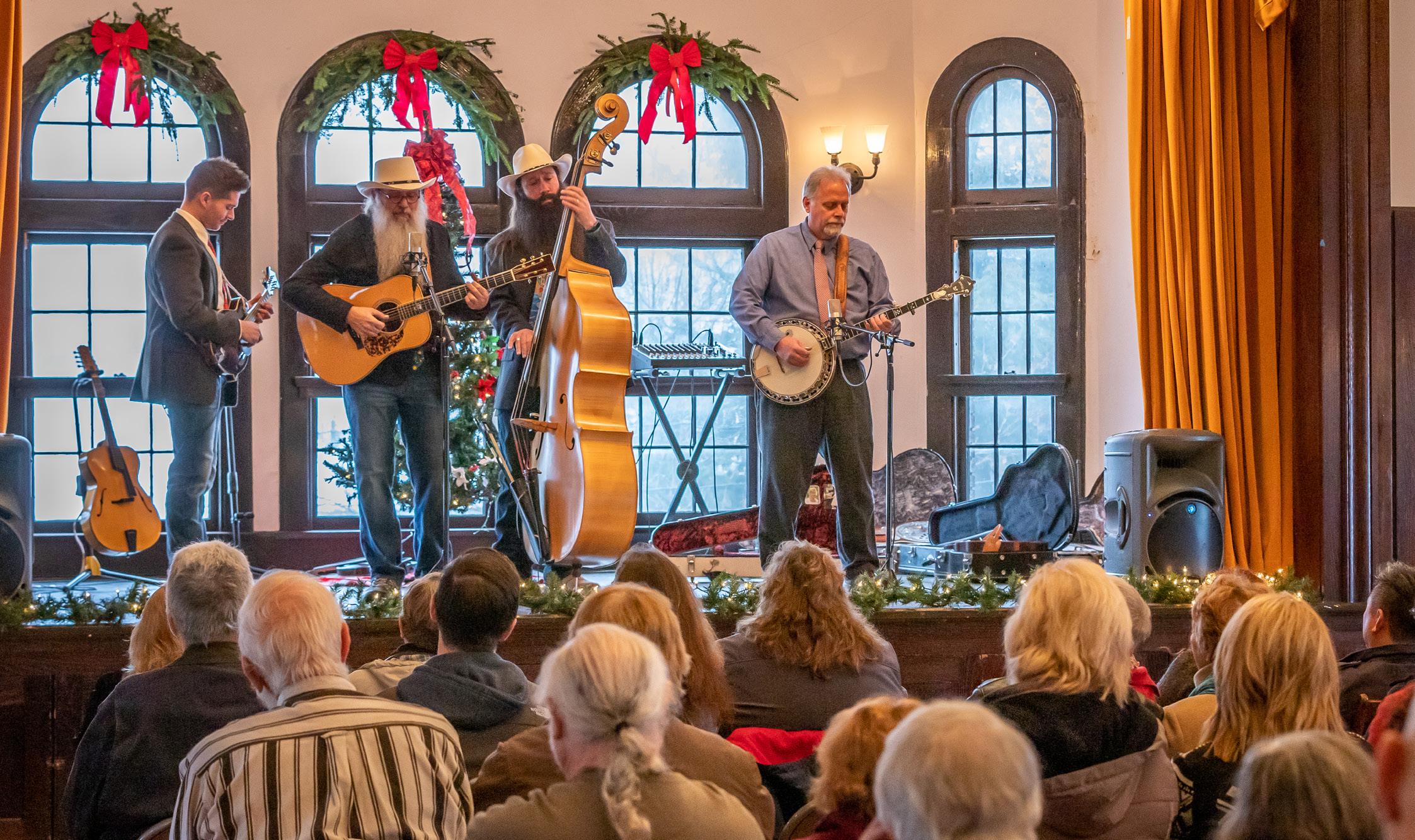
District Arts & Cultural Assets
Creative Placemaking plays a key role in the City’s ability to leverage the power of arts and culture to generate tourism, growth and community transformation. The broader mission is to support the City’s most vulnerable population (24%) that live at or below the poverty line with free or low-cost cultural events. Many of these residents live within the DRI & Opportunity Zone boundaries.
The target area is home to a thriving arts and cultural presence with Art Walks and Public Art Projects on Main Street, artist receptions at the Little Falls Public Library (also on Main Street), and musical performances at the Masonic Hall and Sterzinar Park in Canal Place.
Canal Place has emerged over the years from a dilapidated industrial district into an arts, dining and cultural hub. The Mohawk Valley Center for the Arts, Art Door Gallery, Creative Outpost, popup art shows, public art sculptures, and frequent live performances at Sterzner Park and Canal Side Inn are part of this transformational success story.
Canal Place is also home to numerous festivals throughout the year including Canal Celebration drawing 10,000 people to the City each year, Garlic Festival attracting 3,500 people every year and the recent launch of a Bluegrass Festival with an audience of 1,200 residents and visitors. Distinctive Historic Assets throughout the District
The DRI target area is filled with noteworthy historic assets from City Hall, the Burrell Building, the Snyder Hotel, Little Falls Public Library and Victorian storefronts on Main Street to Canal Place’s Hydro Plant, Vincent Manufacturing, Stone Mill, Gilbert Knitting Mill and other large mills and factories that dot the landscape along the Mohawk River and Erie Canal.

Today, these historic and architecturally significant structures offer desirable adaptive-use residential condominium and waterfront resort development opportunities that advance the City’s vision as a vibrant bedroom community that attracts tourists and visitors throughout the Mohawk Valley and beyond. The building blocks in terms of infrastructure, zoning and City leadership are in place to facilitate current and projected DRI development projects. Disconnected Pedestrian Infrastructure Limits Downtown District Access and Commerce
The Downtown Waterfront District is challenged by vehicular dominance and a disconnection between the Northside neighborhoods and Main Street to Canal Side and the waterfront and the south side residential area/Empire State Trail.
Addressing this isolation and walkability problem will require a pedestrian & bike connectivity loop and the implementation of micro-mobility options throughout the district. Reconnecting the heart of the City creates new opportunities for live/ work entrepreneurs, breweries, cafes, galleries, downtown living and increased commerce for Main Street and Canal Place restaurants, retailers and businesses.
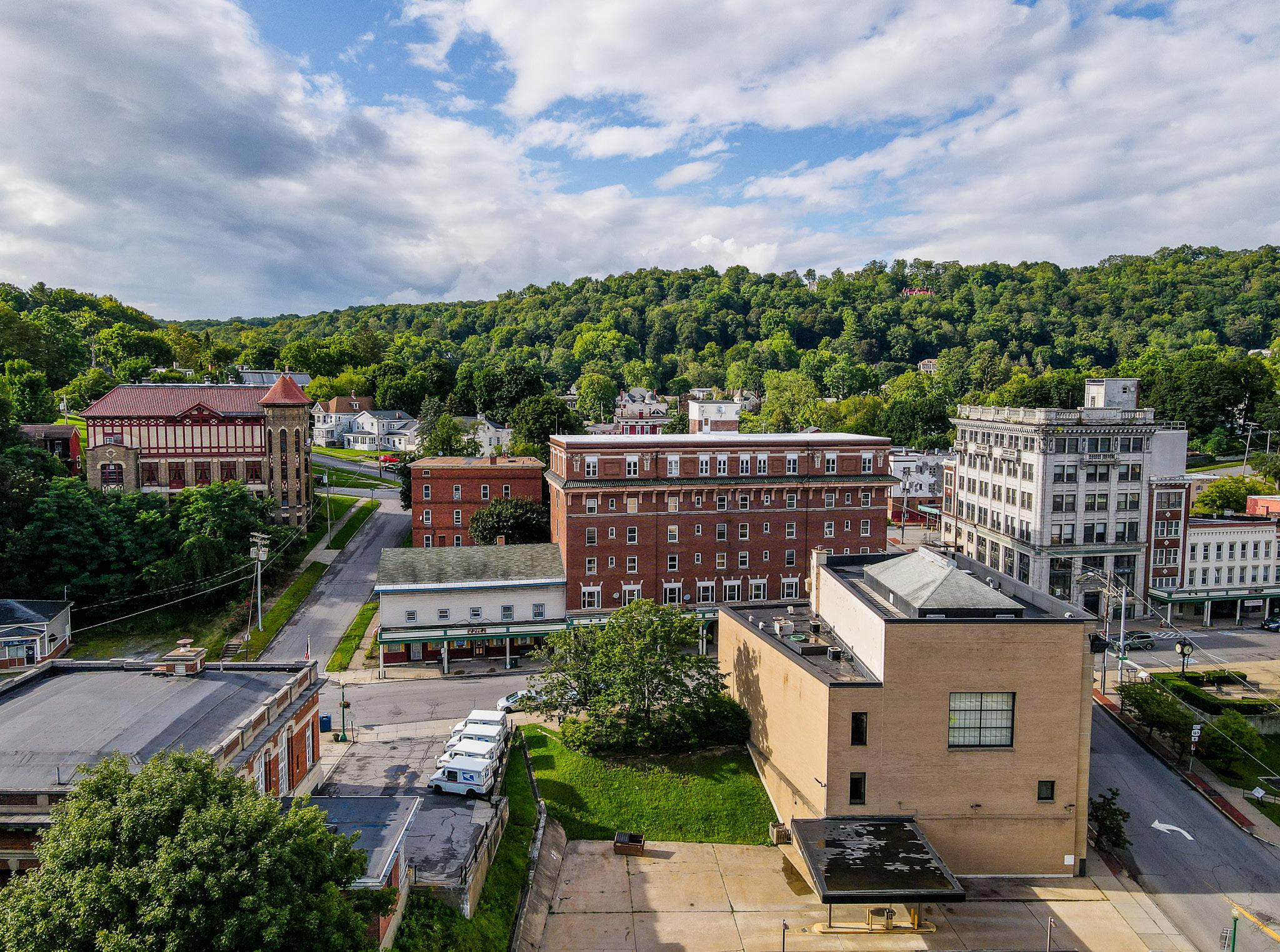
Looking north from Albany Street, showing the iconic Masonic Temple to the left, the former Jefferson Hotel in the middle, and the Burrell bulding on the corner of Main and Ann Street to the right.
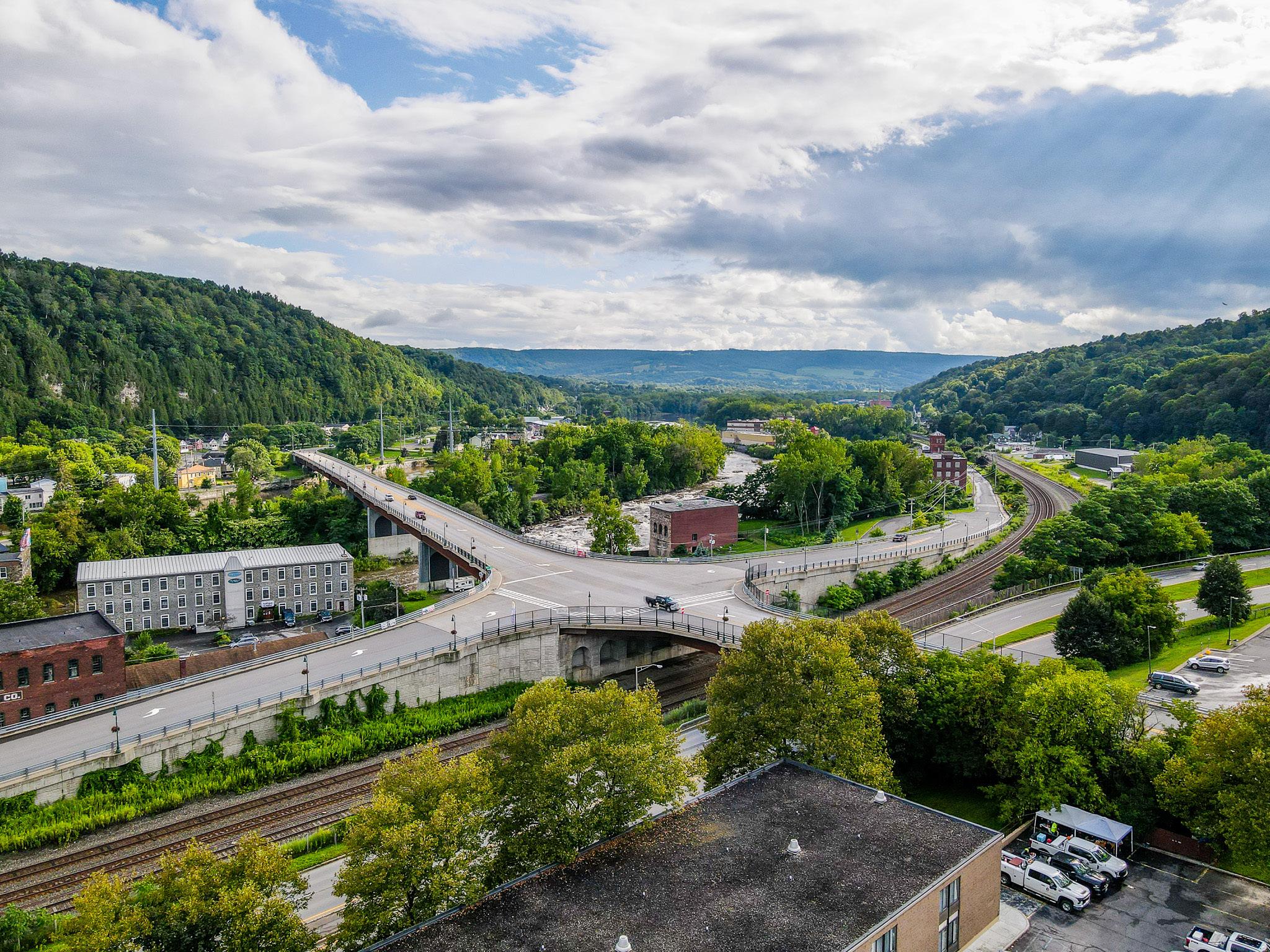
The District’s Challenging and Changing Demographics
As is the case with many post-industrial cities, Little Falls has experienced a decline in population since its recorded peak of 13,029 in 1920, with a 4% drop between 2010 and 2018. The current population of Little Falls, 6,158 (City and Town) is projected to increase only 1.86% over the next five years without a repopulation initiative to entice young families and commuting professionals to relocate to the City. commercial and recreational hub supporting an additional 10,901 residents from the surrounding communities of Dolgeville, Oppenheim/Ephratah, Salisbury, Stratford, St. Johnsville and Canajoharie. This daily surge in population is driven by services and amenities not typically available in rural communities including: a 24-bed hospital and emergency room, physicians, dentists, child care facilities, a comprehensive community center, churches, arts & educational programs, shopping, festivals/events, parks, golf course, waterfront and harbor, cinema, community swimming pool, ice skating rink and their favorite restaurants.
While the City of Little Falls population is in decline from its peak in 1920, its draw area continues to play an important role in the livelihoods of the City’s residents. Little Falls serves as an essential Since the pandemic, the City has also benefited from a growing migration trend originating from remote workers and families seeking the charm and safety of a small-town lifestyle, close enough

to occasionally drive to the office if needed; yet far enough away from the hectic, high-density urban way-of-life. While this is a very recent trend—it is nonetheless—encouraging.
A feasibility study is currently underway to restore passenger train service to Little Falls. With easy rail transit between Little Falls, Albany and NYC— relocation interest could dramatically increase.
An important point to make is that our utilities are already sized to accomodate our peak population and more.
Population Analysis:
The City’s population is well educated with 91% holding a high school degree or higher. The school district’s graduation rate of 80-84% has increased from 75-79% in just over five years. The median age is 41 years, median household income is $42,311, and a median house value is $77,700. 58% of residents own their home.
Many of Little Falls’ most vulnerable residents (the 24% that live at or below the poverty line) live within the DRI target boundaries which also overlaps the designated New York State Opportunity Zone. While repopulation is a key driver in the City’s overall DRI strategy, supporting this vulnerable population is of paramount importance in realizing the DRI vision to support cultural inclusion and community integration. High priority projects include: the Main Street Canopy & Streetscape project opening up 65,000 SF or residential loft space, the Pedestrian & Bike Connectivity Loop connecting the Downtown Waterfront District to the 750-mile Empire State Trail, 2-Way Traffic Conversion on Albany Street, Free Citywide Fiber/WiFi, Additional Downtown Waterfront District Parking and Public Art & Wayfinding Signage directing residents and visitors to points of interest.
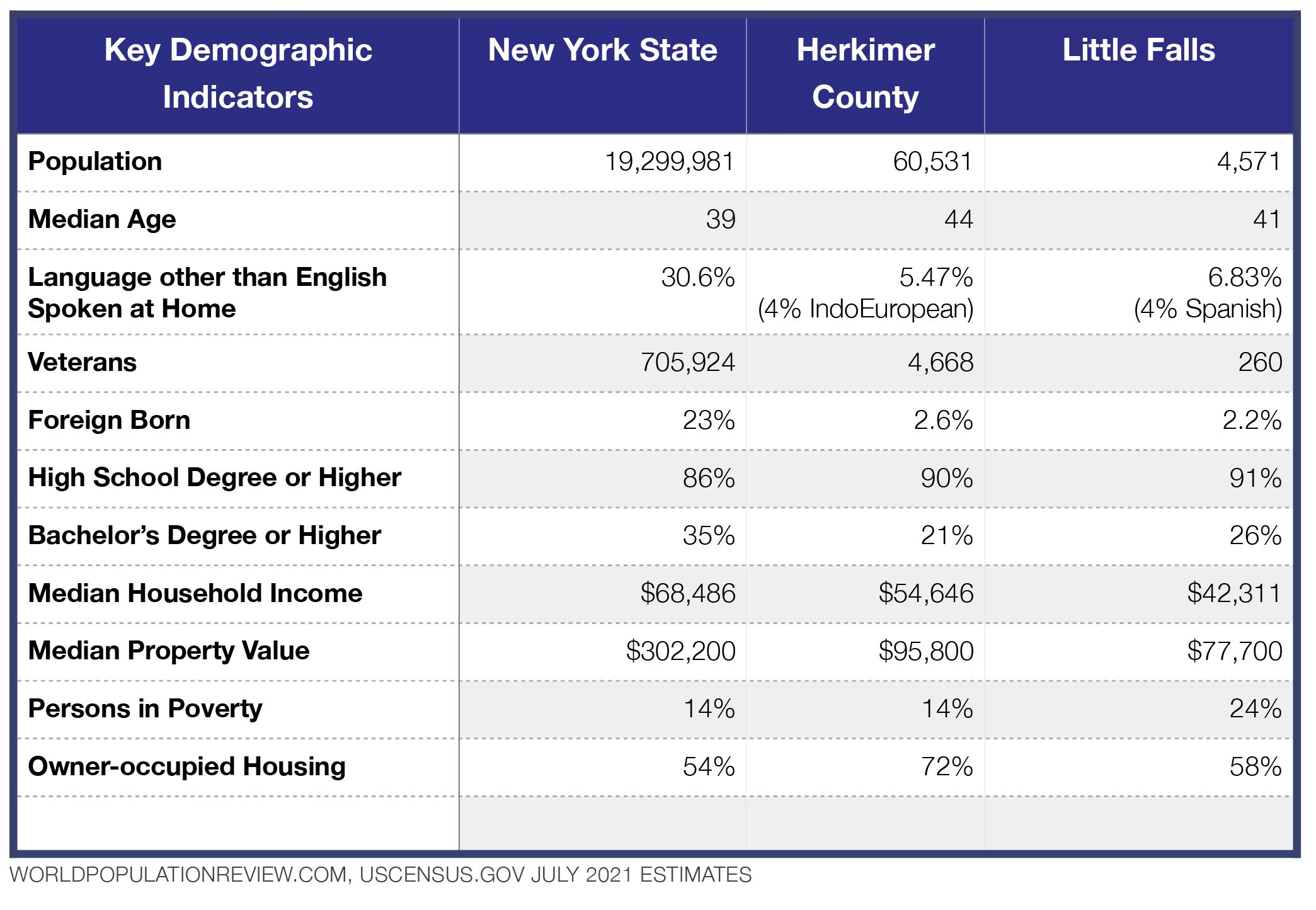
Catalysts for Revitalization
The City of Little Falls is experiencing a rebirth fueled by an extraordinary community commitment, growing interest from developers, and an uptick in residential relocations. What seemed almost impossible just a few years ago, is now a reality, with the City on the cusp of finally seeing its revitalization strategy take hold. With the proposed DRI investments, these grassroots efforts could quickly reach a tipping point for the City’s long-term, sustained prosperity.
1. Enhancing Walkability, Bikeability & Vibrancy
provides a convenient entrance to the Downtown Waterfront District from the recently completed 750-mile Empire State Trail for approximately 40,000 cyclist who normally would transit past the City each year.
The Empire State Trail is particularly popular for residents and the thousands of cyclists that currently visit the City each year in search of lodging, recreational activities, dining, and entertainment. With improved access to the City via the proposed Pedestrian and Bike Connectivity Loop, the numbers of visitors and residents entering the Downtown District will increase exponentially.
An essential part of reconnecting residents and visitors to restaurants, shops, parks, arts and cultural events within the Downtown Waterfront District is restoring the historic infrastructure that once provided extraordinary walkability. By leveraging much of this historic infrastructure and adding natural connecting points with a Pedestrian & Bike Connectivity Loop, the District is fully connected once again.
This 3-mile project maximizes the City’s natural and historic assets as points of interest for residents and visitors to enjoy. It also fuels commerce by reconnecting these disparate areas that today are not safely accessed except by motor vehicle.
The Pedestrian & Bike Connectivity Loop also By working in collaboration with NYPA’s Reimagine the Canal Initiative to extend the eastern portion of the loop to include the rock climbing area at Moss Island, Lock 17, and a future Skybridge across the lock to the Empire State Trail, we’ll create a wide range of attractions for people to explore. It also capitalizes on the City’s unique assets to reinvent ‘the Heart of the City,’ offering an exceptional lifestyle where people prefer to live, work and play.
With funding partners that include the DRI, Reimagine the Canal, Empire State Trail, NYDOT, TAP and local public and private partners, the vision of a fully connected, exceptionally walkable/bikeable Downtown Waterfront District will be once again realized.


Connecting the Canalway Trail and Little Falls / Pedestrian and Bicyclists Map Little Falls
DOWNTOWN
Canalway Trail Big Loop
CANAL PL.
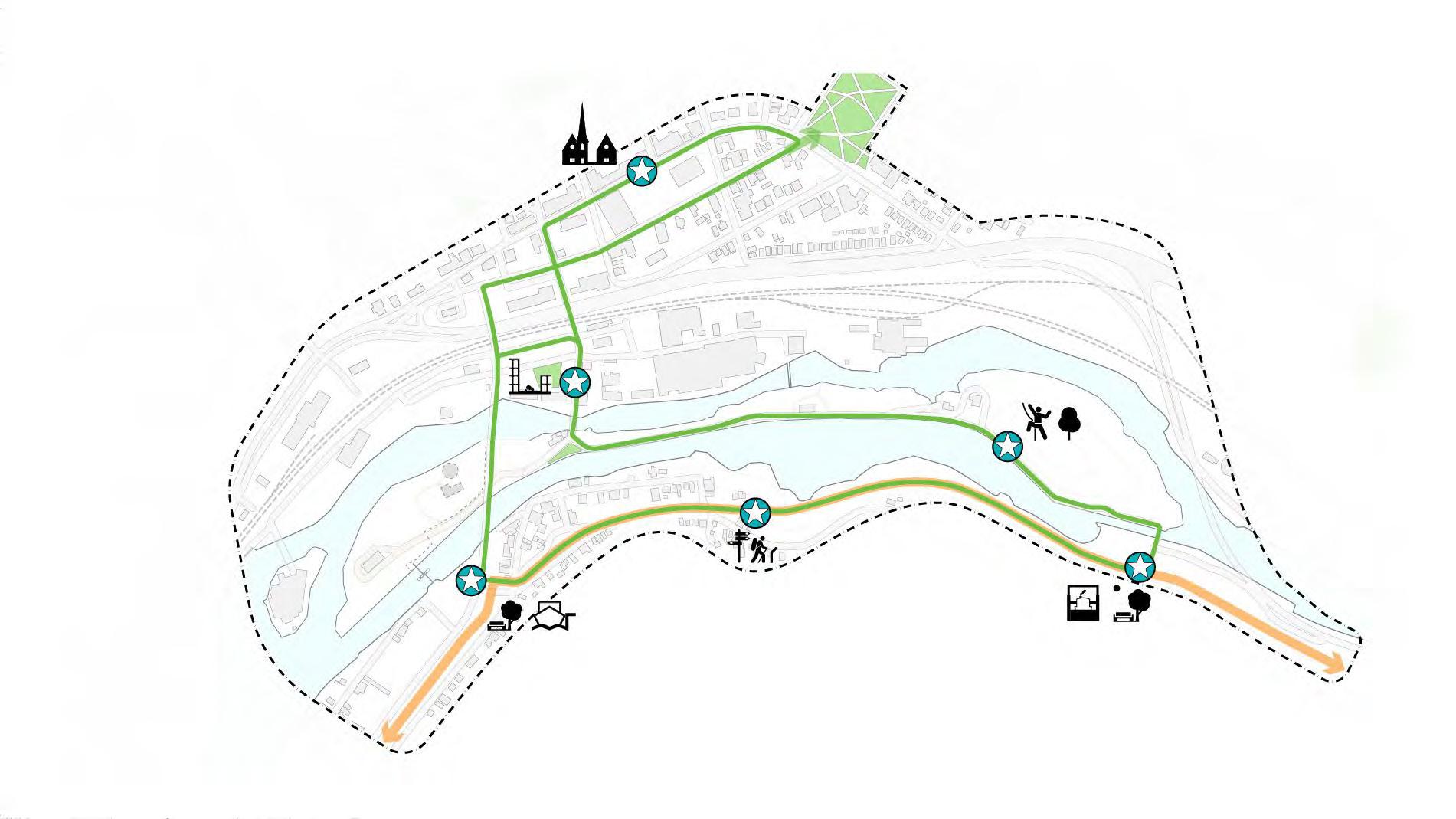

TRAIL GATEWAY WEST CANALWAY TRAIL MOSS ISLAND

LOCK 17 PARK
200 500 1000
2. Leveraging Downtown Anchors & Historic Assets to Attract Business Investment & Relocation
At the center of the Downtown District is an iconic Main Street with one of the prominent architectural features being the vintage canopy. The unique look of Main Street captured the attention of filmmakers in 2018 when the science fiction horror film, A Quiet Place, directed by John Krasinski, was filmed here.
However unique, the canopy protecting the businesses along Main Street is in drastic need of replacement. The canopy replacement project includes a refreshed period design, reinforcement of the canopy structure to be used as a fire escape to support upper level living, seating areas, and potential space for outdoor restaurant service. Streetscape enhancements include: park-like seating areas, dedicated two-way bike lanes, angled street parking, and upgrades to underground utilities.
The ability of this new canopy to serve as a fire escape is a key component that would create a more desirable, safer residential living environment and open up approximately 65,000 sq. ft. of vacant upper-level floors for redevelopment as residential apartments. Based on the existing 45-minute commuting shed patterns, this much-needed residential availability would be particularly attractive to Utica/ Rome commuters seeking a small city lifestyle alternative.
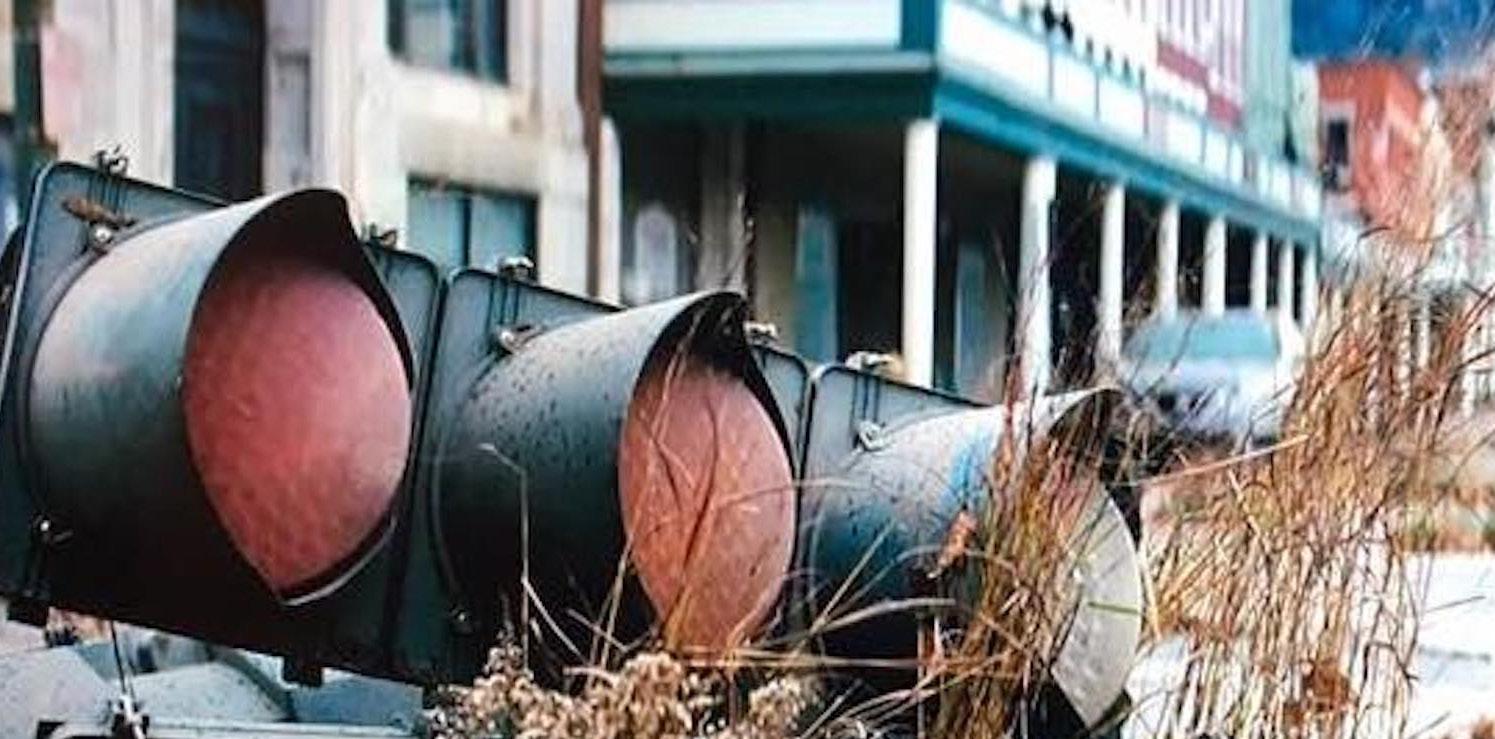
1918 City Hall Renovations
Little Falls Preserve Our Past and the City of Little Falls contracted Crawford & Sterns Architects in 2014 to generate a needs assessment report of the historic City Hall building. The initial phase of addressing these issues gives priority to critical and high priority items in need of immediate attention including: a new boiler along with a facade renovation, correction of leaks at the front gabled pediment, a new roof and asbestos/lead abatement.
Main Street Enhancement Fund
The current occupants of the building include: Little Falls Fire Department, Police Department, Court Clerk and court rooms, City Clerk, Treasurer, Mayor’s office, and Council Chambers, City Engineer, Codes Enforcement and Urban Renewal.
This 3-1/2 story, steel frame building faced in brick and terra cotta in the Classic Revival style is one of the most valued historic treasures in the City and in need of critical repairs as well as environmental safety measures. The Main Street Enhancement Fund is designed to celebrate the City’s historic character, create a cleaner and more inviting atmosphere for new residents and businesses, boost tourism and film industry interest in our iconic Main Street, and encourage commerce among our downtown restaurants and retailers.
This revitalization project will be spearheaded by our local Main Street First group, a 501C(3)
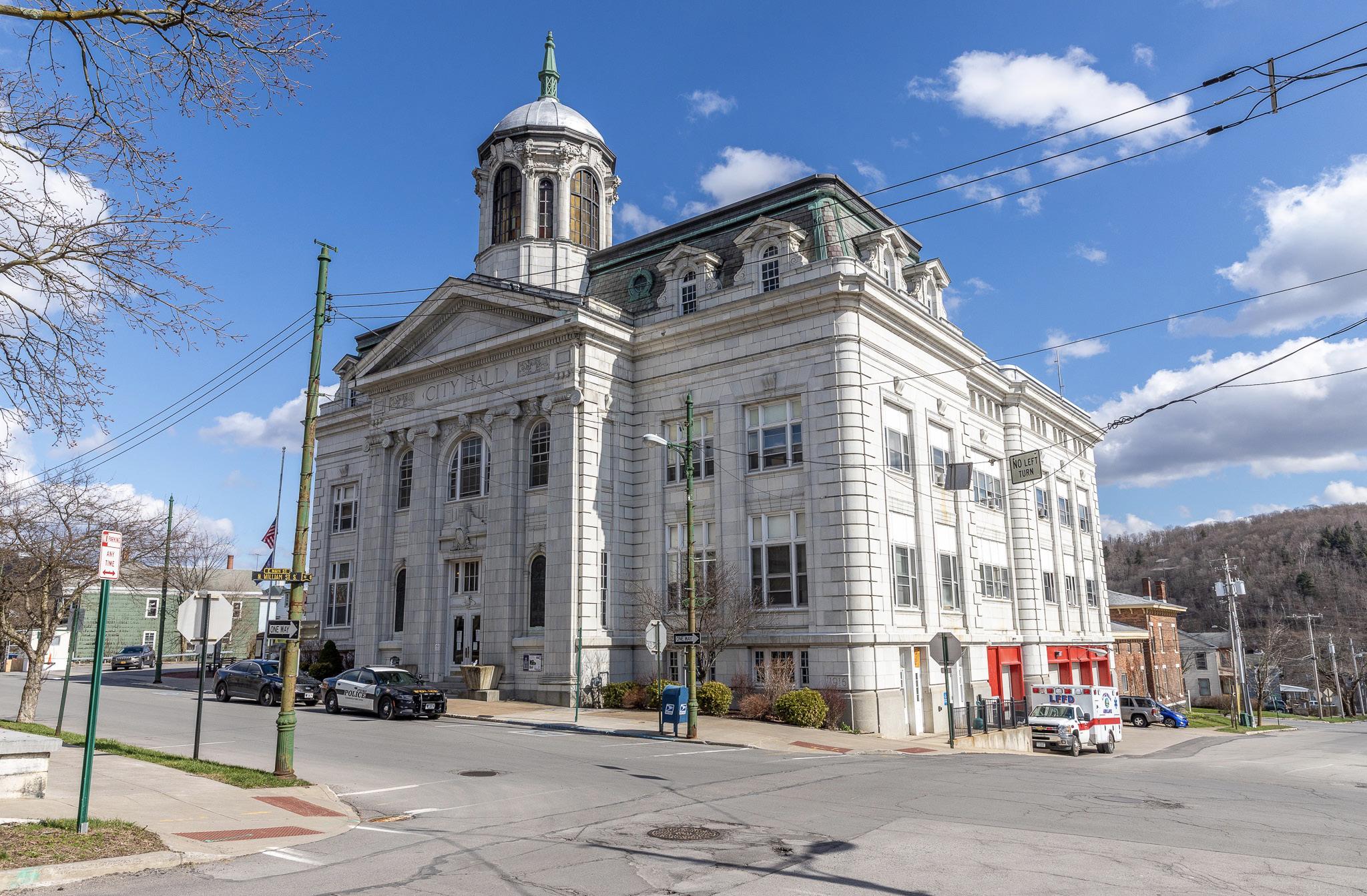


Each year, the City holds its week long Canal Celebration, which includes a parade down Main Street with thousands of people lining the route.
non-profit organization. The project is designed to support the opening of businesses in vacant storefronts on Main Street and generate the momentum and commercial density necessary to attract visitors/residents to the Downtown District. This multifaceted program includes: financial support for lease expenses and tenant improvements, mentoring services in the areas of marketing/social media, business planning, and legal support provided by knowledgeable business leaders.
Dispersement of funds will occur through a juried selection with a scoring system that includes: financial realities, a robust business plan concept, community need, the applicant’s experience and support network, applicant financial strength, and additional points for supporting underserved populations as defined
by the State of NY.
The vision of this revitalization project is that property owners will see an increase in the value of their properties and the revenue potential of developing their upper-level floors into residential apartments, made possible by the structural changes and fire-escape features of the DRI Main Street Canopy project. The addition of fire escapes to these properties opens up approximately 65,000 SF of residential rental income for Main Street property owners.
With refreshed storefronts and renovations to the properties on Main Street, business owners will attract more customers, resulting in increase traffic, sales and referrals. As sales improve and buildings appreciate in value, the entire community benefits from a downtown that is
more vibrant, cleaner and safer.
A reinvigorated Main Street becomes a catalyst for business growth and investment, providing residents with access to a broader range of high-quality goods/services, cultural enrichment, entertainment, and residential housing options. 3. Create Amenities to Enhance District Living & Quality of Life
Two-way Traffic Conversion: Albany Street
Currently, traffic flow through the Downtown District consists of a one-way traffic configuration along Main and Albany Streets, presenting a confusing and difficult to navigate downtown, which was pointed out in a recent SHoP/Buro Happold study. Ease-of-access to businesses and attractions in the district is extremely limited by the existing traffic pattern. Converting the traffic pattern through the Downtown District will provide a more welcoming and easier to navigate downtown, resulting in greater economic vitality for businesses and improved safety for pedestrians and bicycles. The conversion project includes: evaluating and implementing roadway and multi-use pavement widths throughout the project area, pavement markings, evaluating and upgrading user lighting and traffic lighting, replacing signage, and installing much-needed streetscaping along the routes with green infrastructure to mitigate stormwater runoff, thereby encouraging groundwater recharge and reducing the impact of combined storm and sanitary sewer flows to our treatment facilities. Complete Streets
The City of Little Falls has incorporated the transit, equity and health benefits of Complete Street principles into its Comprehensive Plan, zoning code updates, and the recently announced Downtown Waterfront District plan with the 3-mile Pedestrian & Bike Connectivity Loop. Actualization of this pedestrian-oriented vision includes an ongoing communication campaign to educate and engage residents in the transformation process, communicating incremental changes in the District’s development practices as they occur.
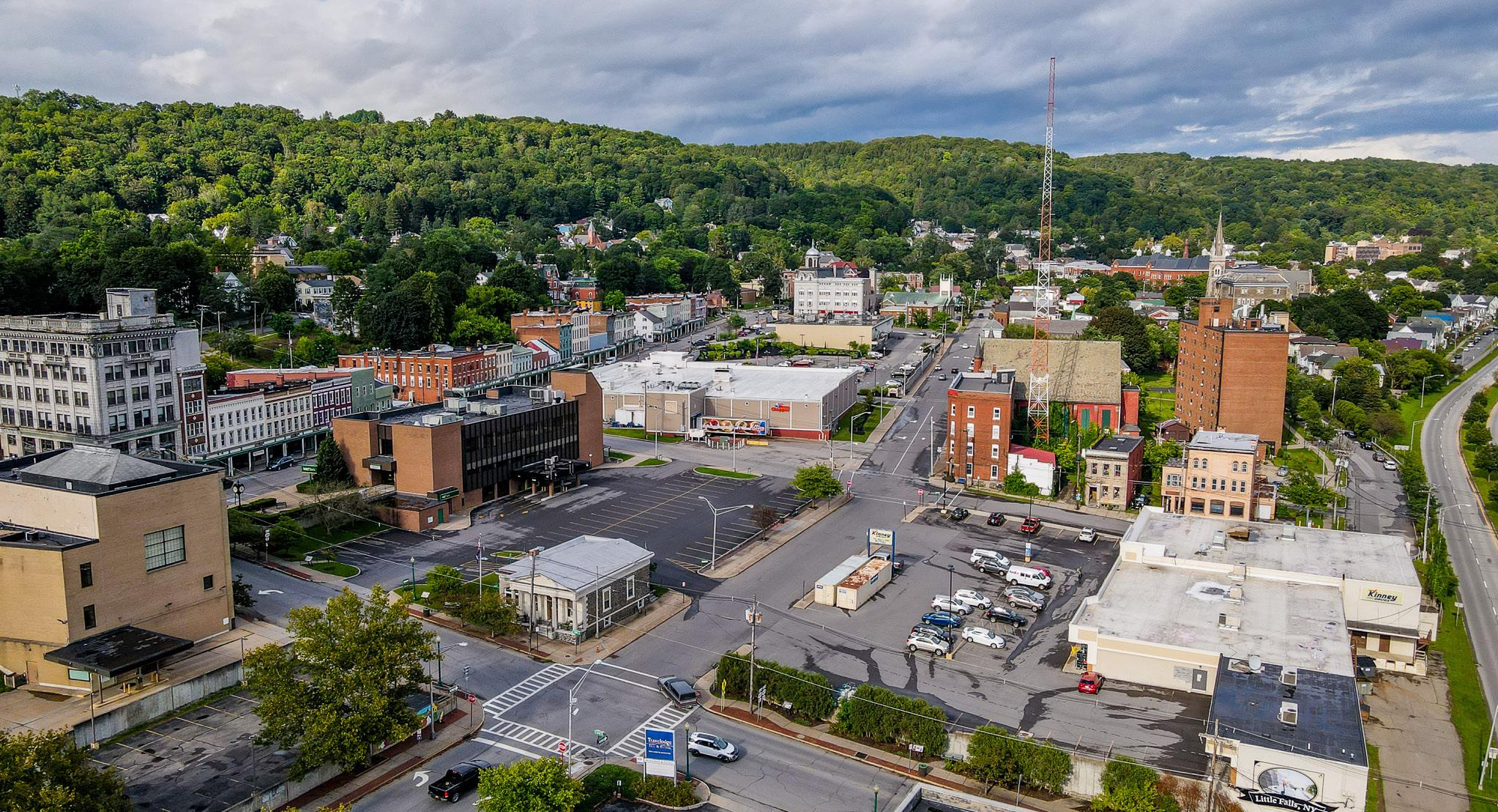

Green Infrastructure Program
The City of Little Falls is in the early stages of site design for its NYSDEC Stormwater Management Plan. This green infrastructure strategy incorporates site and neighborhoodspecific practices with runoff reduction techniques that include a future storm sewer disconnection project along with a full GIGP program to reduce the amount of Stormwater running into the City’s sanitary sewer system. The Main Street DRI projects will also incorporate the City’s green-design vision with stormwater planters as part of its streetscape to capture roof runoff from downtown buildings. Citywide Fiber/WiFi
FirstLight is assisting the City of Little Falls, NY with their effort to provide high speed fiber optic Internet to 13 community anchor institutes within their municipality as part of the Downtown Revitalization Initiative.
The City Wireless Network is a fiber-based citywide wireless network, which works by providing broadband via Wi-Fi to a large part of

the City by deploying a wireless mesh network. Wi-Fi and broadband Internet access are integral to being an active and engaged citizen in today’s world. Bridging the digital divide is an important right for our residents and just as important for the future of our city.
Smart city projects, which include a citywide Wi-Fi deployment, are able to move the needle on poverty rates by improving digital citizenship and opening the door to greater opportunity. Fiber optic Internet is currently the fastest, most-reliable Internet service available. Fiber increases download and upload speeds and offers users faster access to various media types and larger file sizes. This problem was highlighted when school children in the City were all trying to work remotely at the same time.
FirstLight, headquartered in Albany, New York, provides fiber-optic data, Internet, data center, cloud and voice services to enterprise and carrier customers throughout the Northeast and mid-Atlantic connecting more than 9,000 locations in service with more than 30,000 locations serviceable by their more than 20,000route mile network. FirstLight offers a robust suite of advanced telecommunications products featuring a comprehensive portfolio of high bandwidth connectivity solutions including Ethernet, wavelength and dark fiber services as well as dedicated Internet access solutions, data center, cloud and voice services. FirstLight’s clientele includes national cellular providers and wireline carriers and many leading enterprises, spanning high tech manufacturing and research, hospitals and healthcare, banking and financial, secondary education, colleges and universities, “ I envision the Downtown Waterfront District will... and local and state governments. Additional Wi-Fi hotspot locations will be utilized from the NYPA Street Lighting/Smart Cities Project. Mirco-Mobility - Inclusive Community Initiative
The City’s scooter and bike mobility project is an innovative solution to expanding and enhancing mobility throughout the Downtown Waterfront District and beyond. Offering access to rentable dock-less bikes and scooters equipped with GPS for our residents, workers and visitors that would have access to healthy, environmentally sustainable transportation alternatives that would connect the District.
This project is a public/private partnership with City approved micro-mobility providers. The City would designate stations on Main Street, Canal Place and the Harbor to accommodate bike/scooter rental. The project also includes repair stations throughout the City to leverage the growth of bicycle tourism, national bike tours, and the 750-mile Empire State Trail where approximately 40,000 cyclist pass through the City each year.


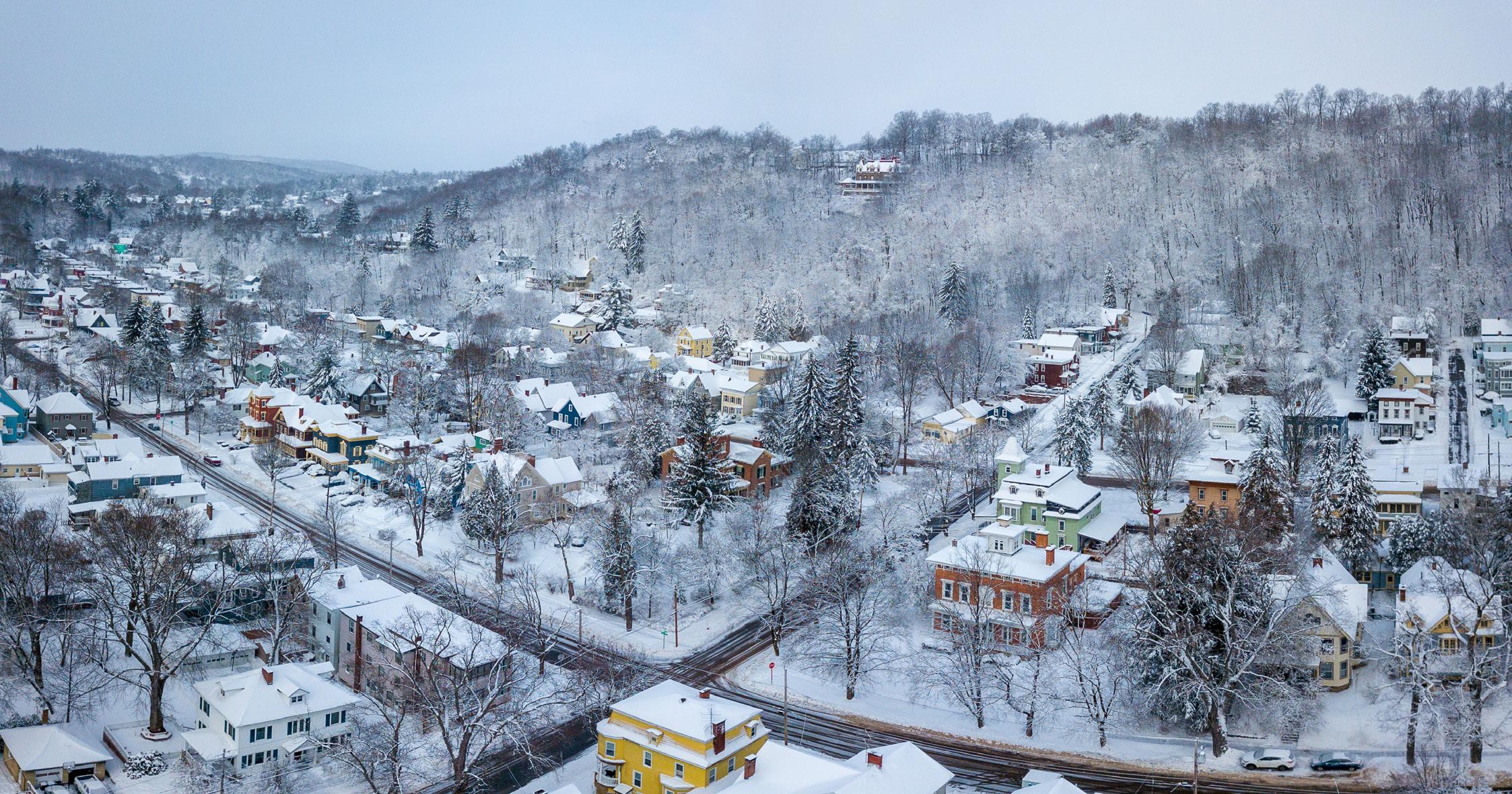
Historic District Housing Fund
The Historic District Housing Fund offers low-interest loans and grants to owners of historic residential properties within the eastern portion of the Downtown District that are in need of rehabilitation. These areas include: portions of East Main Street, Albany Street, John Street, Hancock Street and Petrie Street. Census data indicates over 50% of the residents in this area are of lower income and cannot get conventional financing due to income level and/or the condition of the build and area. Funds generally apply to exterior work or structural repairs to facilitate housing rehabilitation, stabilize living conditions and eliminate health/safety problems, as well as neighborhood blight. 4. Enhance Public Places for Arts & Cultural Events
Event Hall Upgrade: 1914 Historic Masonic Lodge
The historic Masonic Lodge, a castle-like structure perched above Main Street, has been part of the City’s downtown heritage for 106 years. Over the years, this 175-capacity auditorium with stage, and commercial kitchen has hosted countless weddings, art events, and musical performances.
The hall’s intimate setting, ornate victorian details and extraordinary acoustics make it a favorite among residents, visitors and performers. With a growing interest from event planners to bring more live music performances to the City, there is an immediate need to modernize this hall for handicap accessibility. This renovation project includes handicap entrance ramps, the relocation of bathrooms to the event hall level, new plumbing in the kitchen, entryway painting, and plasterwork.

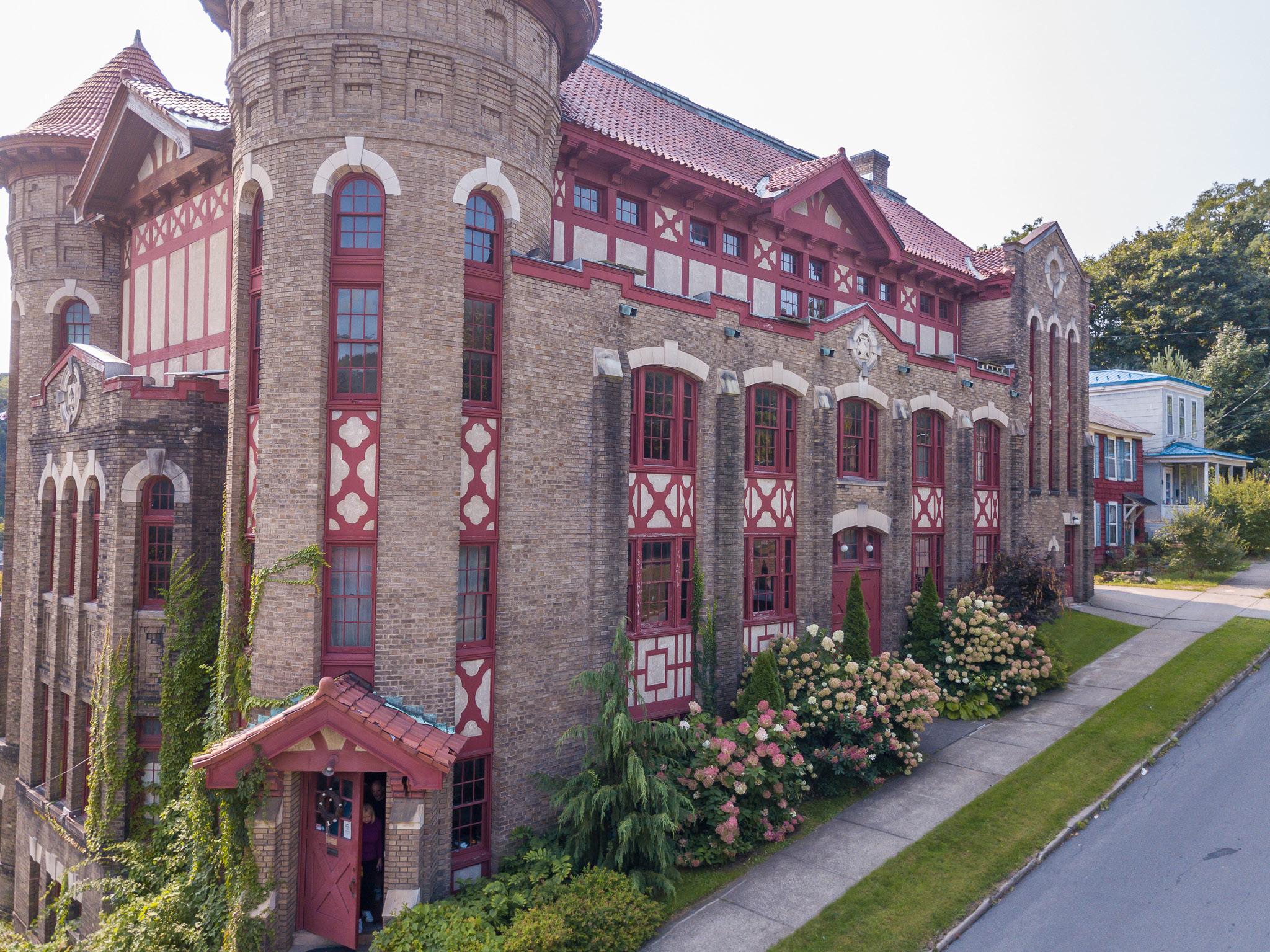
The historic 1914 Masonic Lodge, which in the past, has been home to many arts and cultural events.
Sterzinar Park Improvements - Riverwalk
Sterzinar Park, originally designed as a passive recreation area at the center of Canal Place, has become an increasingly important hub for arts & cultural events, festivals, musical performances and plays. The Sterzinar Park Improvement project “ I envision the Downtown Waterfront District will...
Next Page - Top Right - Overhead view of new park layout, relocation of stage area, additional parking, and deck with river walkway. Bottom Right - View of the walkway over the canal and behind Stone Mill and the Antique Center.
funds the relocation of the current performance stage to accommodate larger audiences with 500 chairs and a 120-seat outdoor dining area, site lighting, sidewalks, pavers, a canopy for the stage, landscaping and a river deck observation area.
DRI Community Survey Input ...

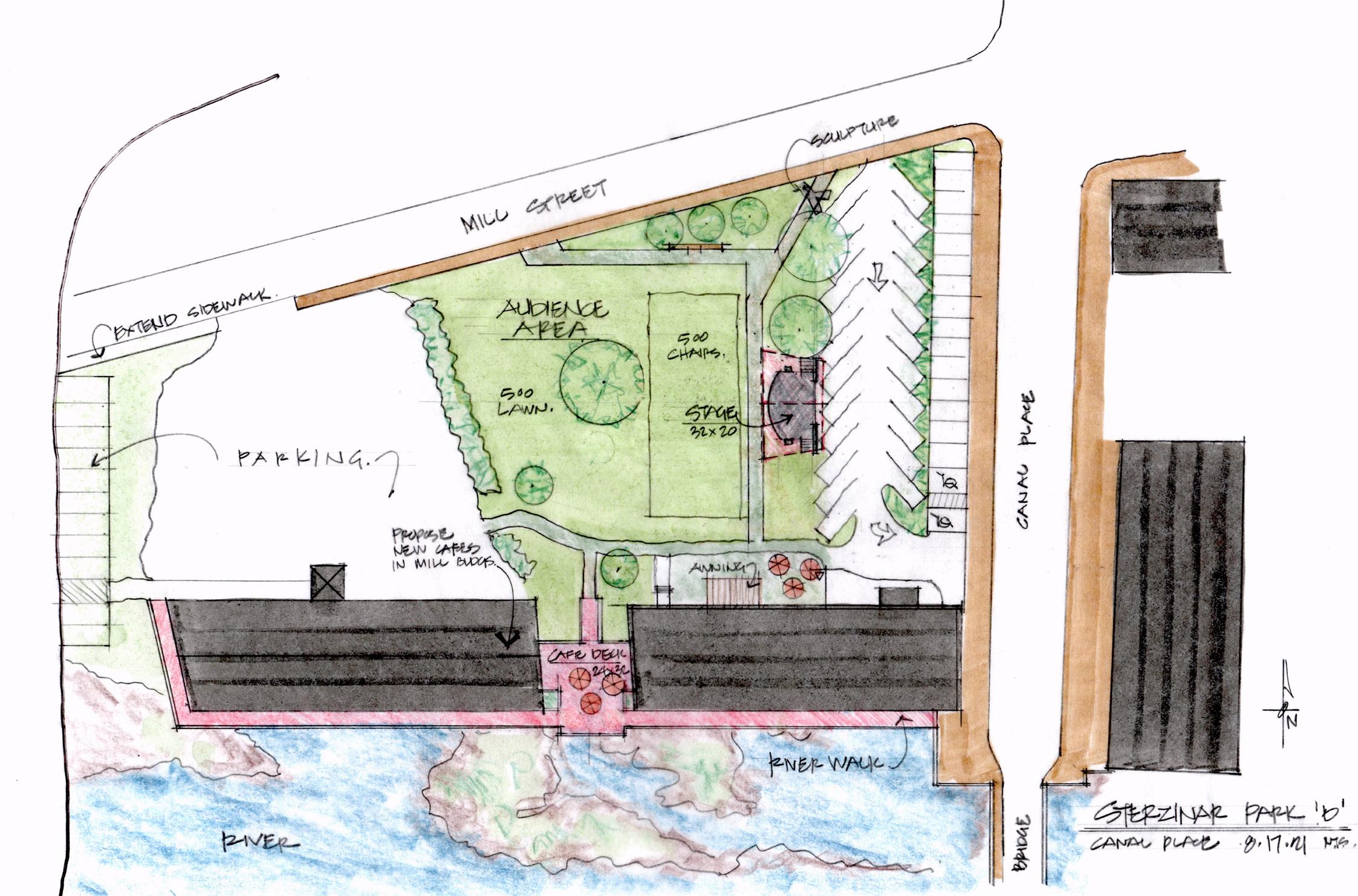

5. Stimulate Physical/Social/ Economic Development
Increase High-Quality Child Care Capacity
Little Falls is a child care ‘desert’ with only 8 home-based day care facilities within a five mile radius.
With 724 children under the age of 12, the current 72-child care capacity is woefully inadequate. The problem is particularly concerning for those with infant-age children, where there is a 2-year waiting list at The Little Falls Youth & Family Center’s certified childcare facilities at 45 Furnace Street. This is one of only a handful of certified facilities in Herkimer County.
This DRI project will initiate much needed facility improvements to its 43 & 45 Furnace Street facilities at the cost of $407,000, and it’s 524 E. Main Street property at the cost of $245,000. The upgrades will modernize and repurpose facilities for increased daily child-care capacity by adding 324 SF to accommodate an additional 10 slots (from 36 to 46) at the Furnace Street Property and 25-35 temporary slots at the Main Street facility, used when school facilities are unavailable.
Upgrades include: Roof replacement, HVAC and lower level program space repairs for 524 E. Main Street including windows, door, and paint. Enhancements to 43 & 45 Furnace Street include: 324 SF building addition, window replacements, boiler, parking lot paving, painting, repairs and maintenance. Also included for both properties is distributed WiFi infrastructure with operations, security and control access and four workstations for free Internet accessibility to low income families.
